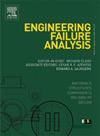A novel TCD framework for fatigue lifetime prediction incorporating defect and stress concentration effects
IF 4.4
2区 工程技术
Q1 ENGINEERING, MECHANICAL
引用次数: 0
Abstract
Defects in powder metallurgy (PM) superalloy tend to become a source of cracks under cyclic loading, reducing the fatigue lifetime of crack initiation and affecting the safety of aero-engines. The mechanism of crack initiation is affected by both the defect type and the gradient stress distribution, resulting in the large difference of fatigue lifetime. To study the relationship between the defect type at the crack source and the fatigue lifetime under the influence of stress concentrations, a series of fatigue experiments of notched round bar specimens were carried out. Then a modified theory of critical distance (TCD) on the basis of concern range of defect was proposed, which accommodates both surface defects and internal defects cracking mechanism. Compared to the experimental results, prediction results of fatigue lifetime fell within a scatter band of ±4. Finally, a concept of inclusion sensitive area (ISA) was proposed to quantify the area of stress concentration that was susceptible to cracking due to inclusion. It was validated by the fracture surface observation, where all inclusions on crack sources in the experiment were within the predicted region. This work will support lifetime prediction and defect detection strategies for aero-engine components.

结合缺陷和应力集中效应的新型TCD疲劳寿命预测框架
粉末冶金高温合金的缺陷在循环载荷作用下容易成为裂纹的来源,降低裂纹萌生的疲劳寿命,影响航空发动机的安全性。裂纹的起裂机制受缺陷类型和梯度应力分布的影响,导致疲劳寿命差异较大。为了研究应力集中作用下裂纹源处缺陷类型与疲劳寿命的关系,进行了一系列缺口圆棒试件的疲劳试验。在此基础上,提出了基于缺陷关注范围的修正临界距离理论(TCD),该理论既适用于表面缺陷,也适用于内部缺陷开裂机理。与试验结果相比,疲劳寿命预测结果落在±4的散射范围内。最后,提出了夹杂物敏感区(ISA)的概念,以量化夹杂物易开裂的应力集中区域。通过对断口表面的观察证实了这一点,实验中裂纹源上的夹杂物均在预测范围内。这项工作将支持航空发动机部件的寿命预测和缺陷检测策略。
本文章由计算机程序翻译,如有差异,请以英文原文为准。
求助全文
约1分钟内获得全文
求助全文
来源期刊

Engineering Failure Analysis
工程技术-材料科学:表征与测试
CiteScore
7.70
自引率
20.00%
发文量
956
审稿时长
47 days
期刊介绍:
Engineering Failure Analysis publishes research papers describing the analysis of engineering failures and related studies.
Papers relating to the structure, properties and behaviour of engineering materials are encouraged, particularly those which also involve the detailed application of materials parameters to problems in engineering structures, components and design. In addition to the area of materials engineering, the interacting fields of mechanical, manufacturing, aeronautical, civil, chemical, corrosion and design engineering are considered relevant. Activity should be directed at analysing engineering failures and carrying out research to help reduce the incidences of failures and to extend the operating horizons of engineering materials.
Emphasis is placed on the mechanical properties of materials and their behaviour when influenced by structure, process and environment. Metallic, polymeric, ceramic and natural materials are all included and the application of these materials to real engineering situations should be emphasised. The use of a case-study based approach is also encouraged.
Engineering Failure Analysis provides essential reference material and critical feedback into the design process thereby contributing to the prevention of engineering failures in the future. All submissions will be subject to peer review from leading experts in the field.
 求助内容:
求助内容: 应助结果提醒方式:
应助结果提醒方式:


